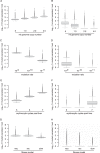Emergence of resistance to atovaquone-proguanil in malaria parasites: insights from computational modeling and clinical case reports
- PMID: 24867967
- PMCID: PMC4136057
- DOI: 10.1128/AAC.02550-13
Emergence of resistance to atovaquone-proguanil in malaria parasites: insights from computational modeling and clinical case reports
Abstract
The usefulness of atovaquone-proguanil (AP) as an antimalarial treatment is compromised by the emergence of atovaquone resistance during therapy. However, the origin of the parasite mitochondrial DNA (mtDNA) mutation conferring atovaquone resistance remains elusive. Here, we report a patient-based stochastic model that tracks the intrahost emergence of mutations in the multicopy mtDNA during the first erythrocytic parasite cycles leading to the malaria febrile episode. The effect of mtDNA copy number, mutation rate, mutation cost, and total parasite load on the mutant parasite load per patient was evaluated. Computer simulations showed that almost any infected patient carried, after four to seven erythrocytic cycles, de novo mutant parasites at low frequency, with varied frequencies of parasites carrying varied numbers of mutant mtDNA copies. A large interpatient variability in the size of this mutant reservoir was found; this variability was due to the different parameters tested but also to the relaxed replication and partitioning of mtDNA copies during mitosis. We also report seven clinical cases in which AP-resistant infections were treated by AP. These provided evidence that parasiticidal drug concentrations against AP-resistant parasites were transiently obtained within days after treatment initiation. Altogether, these results suggest that each patient carries new mtDNA mutant parasites that emerge before treatment but are killed by high starting drug concentrations. However, because the size of this mutant reservoir is highly variable from patient to patient, we propose that some patients fail to eliminate all of the mutant parasites, repeatedly producing de novo AP treatment failures.
Copyright © 2014, American Society for Microbiology. All Rights Reserved.
Figures



Similar articles
-
Clinical implications of Plasmodium resistance to atovaquone/proguanil: a systematic review and meta-analysis.J Antimicrob Chemother. 2018 Mar 1;73(3):581-595. doi: 10.1093/jac/dkx431. J Antimicrob Chemother. 2018. PMID: 29237012 Free PMC article.
-
Inhibition of merozoite invasion and transient de-sequestration by sevuparin in humans with Plasmodium falciparum malaria.PLoS One. 2017 Dec 15;12(12):e0188754. doi: 10.1371/journal.pone.0188754. eCollection 2017. PLoS One. 2017. PMID: 29244851 Free PMC article. Clinical Trial.
-
Mutations in the Plasmodium falciparum cytochrome b gene are associated with delayed parasite recrudescence in malaria patients treated with atovaquone-proguanil.Malar J. 2008 Nov 20;7:240. doi: 10.1186/1475-2875-7-240. Malar J. 2008. PMID: 19021900 Free PMC article.
-
Clinical atovaquone-proguanil resistance of Plasmodium falciparum associated with cytochrome b codon 268 mutations.Microbes Infect. 2006 Sep;8(11):2599-604. doi: 10.1016/j.micinf.2006.07.011. Epub 2006 Aug 10. Microbes Infect. 2006. PMID: 16962361
-
Atovaquone and proguanil hydrochloride for prophylaxis of malaria.J Travel Med. 1999 May;6 Suppl 1:S21-7. J Travel Med. 1999. PMID: 23573549 Review.
Cited by
-
Current therapies and future possibilities for drug development against liver-stage malaria.J Clin Invest. 2016 Jun 1;126(6):2013-20. doi: 10.1172/JCI82981. Epub 2016 Jun 1. J Clin Invest. 2016. PMID: 27249674 Free PMC article. Review.
-
Clinical implications of Plasmodium resistance to atovaquone/proguanil: a systematic review and meta-analysis.J Antimicrob Chemother. 2018 Mar 1;73(3):581-595. doi: 10.1093/jac/dkx431. J Antimicrob Chemother. 2018. PMID: 29237012 Free PMC article.
-
Late clinical failure associated with cytochrome b codon 268 mutation during treatment of falciparum malaria with atovaquone-proguanil in traveller returning from Congo.Malar J. 2020 Jan 21;19(1):37. doi: 10.1186/s12936-020-3126-y. Malar J. 2020. PMID: 31964401 Free PMC article.
-
A screen of drug-like molecules identifies chemically diverse electron transport chain inhibitors in apicomplexan parasites.PLoS Pathog. 2023 Jul 20;19(7):e1011517. doi: 10.1371/journal.ppat.1011517. eCollection 2023 Jul. PLoS Pathog. 2023. PMID: 37471441 Free PMC article.
-
Advanced Molecular Detection of Malarone Resistance.Antimicrob Agents Chemother. 2016 May 23;60(6):3821-3. doi: 10.1128/AAC.00171-16. Print 2016 Jun. Antimicrob Agents Chemother. 2016. PMID: 27001821 Free PMC article.
References
-
- Hoyer S, Nguon S, Kim S, Habib N, Khim N, Sum S, Christophel EM, Bjorge S, Thomson A, Kheng S, Chea N, Yok S, Top-Ros SS, Sophal U, Thompson MM, Mellor S, Ariey F, Witkowski B, Yeang C, Yeung S, Duong S, Newman RD, Menard D. 2012. Focused screening and treatment (FSAT): a PCR-based strategy to detect malaria parasite carriers and contain drug resistant P. falciparum, Pailin, Cambodia. PLoS One 7:e45797. 10.1371/journal.pone.0045797 - DOI - PMC - PubMed
Publication types
MeSH terms
Substances
LinkOut - more resources
Full Text Sources
Other Literature Sources

